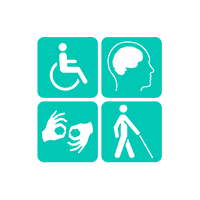Accessibility for People with Disabilities or Reduced Mobility
The society in which we live is characterized by heterogeneity: of thoughts, actions, creeds, ethnicities, groups and people. Physical characteristics such as deficiencies, obesity, dwarfism, or even everyday activities also generate difficulties and needs. All these situations have in common the question of accessibility, whose concept is aimed at all citizens and is understood as a condition to provide the whole population with security and autonomy – whether full or assisted – in the use of spaces, tours, equipment, buildings, transport services and devices, systems and media.
Accessibility aims at ensuring mobility, which is a basic and necessary condition for an individual to enjoy the uses of public and common spaces in an autonomous manner and with the equalization of opportunities. Promoting accessibility means allowing everyone to attend public spaces and create inclusive environments, not only geared towards the facilities, but also enabling the training and awareness of the population.
Providing accessibility is to allow the integration of difference, alleviate difficulties and contribute to social inclusion, guaranteeing freedom of movement and access, that is, consecrated the constitutional principles of coming and going and promoting the well-being of all without prejudice, in addition to corroborate the first premise of Human Rights that proclaims that all human beings are free and equal.
With the aim of creating an even more integrated city, projects such as Rotas Acessíveis were born. The proposal is to create routes based on the need to travel between public transport stations and points of interest for people with disabilities or reduced mobility. Examples of these points would be: hospitals, public services, schools, colleges, malls, theaters, parks, among others.
For this, our methodology consists of:
- Capitation of Information;
- Project analysis;
- Analysis of certification documentation;
- Technical inspection;
- Diagnosis;
- Elaboration of report for inspection and guidance;
- Follow-up of supervision;
- Follow-up of adjustments;
- Certification;
- Mapping.
Related Posts

Alignment for quality On 13/4, IEME Brasil held a meeting of the company's key employees to align procedures, in São... 
Permanent way monitoring Instrumented wheelset campaign brings more safety to... 
Paraguay inaugurates Heroes del Chaco bridge IEME Brasil and LAEDE carried out all static and dynamic tests to assess the safety of the structure and allow it to be released to... 
Inmetro revalidates IEME Brasil accreditation for inspection of road and rail projects The National Institute of Metrology, Quality and Technology (Inmetro) has just concluded its annual audit and revalidated the status of IEME Brasil Accredited Inspection Body (OIA), obtained at the...

